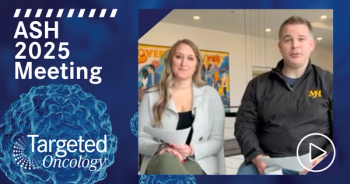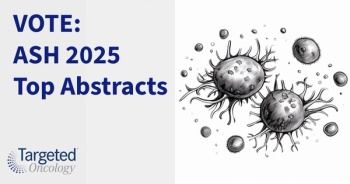
Long-Term OS Data for Axi-Cel Hint Short-Term EFS is a Surrogate End Point for R/R LBCL
According to a long-term analysis of the ZUMA-1 study, the overall survival rate yielded by axicabtagene ciloleucel may support 1- and 2-year event-free survival as a surrogate end point in relapsed/refractory large B-cell lymphoma.
In patients with relapsed/refractory large B-cell lymphoma (LBCL), the long-term overall survival (OS) findings of the phase 2 ZUMA-1 trial appears to support the 1- and 2-year event-free survival (EFS) findings of axicabtagene ciloleucel (axi-cel), according to data presented at the 2022 Transplantation & Cellular Therapy Meetings.
“In this updated 5-year analysis, axi-cel induced long-term OS...among treated patients,” according to Caron A. Jacobson, MD, MMSc, the medical director of the Immune Effector Cell Therapy Program and senior physician at Dana-Farber Cancer Institute and an assistant professor of medicine at Harvard Medical School. She continued, “Between the 4- and 5-year analysis, the time to next therapy curve remains stable and 92% of patients remained alive without a need for subsequent therapy, which may be suggestive of a cure in these patients.”
Investigators reported a 5-year OS rate of 42.6% (95% CI, 32.8%-51.9%) following treatment with axi-cel. In the population of patients who experienced a complete response, the 5-year OS rate was 64.4% (95% CI, 50.8%-75.1%) and the median OS was not reached (95% CI, 63.4–not estimated). Additionally, 63% of complete responders were alive at the 5-year data cut off. At the 4-year data cutoff, 1 patient died at month 63 and one experienced progressive disease at month 54.
To be considered for treatment, patients were required to have LBCL, including diffuse large B-cell lymphoma, primary mediastinal B-cell lymphoma, or transformed follicular lymphoma. Patients were also required to have not responded to their last chemotherapeutic or have relapsed 12 months or less following autologous stem cell transplant. Treatment with a previous anti-CD20 monoclonal antibody and anthracycline was also necessary.
Those who underwent treatment received a conditioning regimen of cyclophosphamide at 500 mg/m2 and 30 mg/m2 of fludarabine for 3 days. This was followed by axi-cel at a dose of 2x106 CAR T-cells/kg. The primary end point was overall response rate with first response assessment 4 weeks following infusion, Key secondary end points included OS, safety, and translational evaluations.
A total of 111 patients were enrolled on the study, 8 of whom did not undergo treatment due to adverse effects (AEs; n = 4), no measurable disease (n = 2), death due to disease progression (n = 1), and manufacturing failure (n =1); this left 103 patients to undergo conditioning. Of these patients 2 were not treated due to AEs and death, respectively. One hundred and three patients underwent infusion. The data cutoff was August 11, 2021 and the median follow-up was 63.1 months.
Additional findings from the trial highlighted a median time to next anticancer therapy of 8.7 months following infusion. A total of 34% of patients were alive at cutoff with no subsequent therapy or retreatment with axi-cel. Two patients who had prior progression underwent new anticancer therapy.
The 5-year OS rates among those who had or had not experienced an EFS event at month 12 were 5.3% vs 90.9%, respectively. The median OS was 8.3 months among those who experienced an event and was not reached in those who did not experience an event. Additionally, the 5-year OS rates among those who did or did not have an EFS event at month 24 were 11.3% and 92.3%, respectively. Moreover, the median OS in both respective groups was 9.2 months and not reached.
Investigators also determined that early CAR T-cell expansion was associated with ongoing response at 60 months. The median peak CAR T levels appeared to be numerically higher in those who had an ongoing response at month 60 and lower in those who relapsed or did not respond to treatment. Similarly, another trend was observed in those who experienced CAR T-cell expansion by area under the curve from day 0 to 28.
A total of 58% of patients had died by the cutoff date. No new safety signals had been observed as of the 5-year data cutoff, including serious AEs or secondary malignancies related to treatment. Patients most commonly died due to progressive disease (n = 45), AEs (n = 4), secondary malignancies (n = 1), or other reasons (n = 9).
Reference
Jacobson C, Locke FL, Ghobadi A, et al. Long-term (5 year) overall survival in Zuma-1, the pivotal study of axicabtagene ciloleucel (Axi-Cel) in patients with refractory large B-cell lymphoma (LBCL). Presented at: 2022 Tandem Meetins; April 23-26, 2022; Salt Lake City, UT. Abstract 10.









































